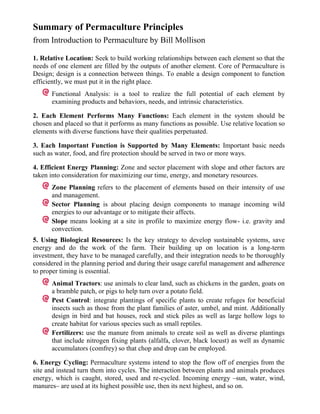
Bill Mollison principles summary
- 1. Summary of Permaculture Principles from Introduction to Permaculture by Bill Mollison 1. Relative Location: Seek to build working relationships between each element so that the needs of one element are filled by the outputs of another element. Core of Permaculture is Design; design is a connection between things. To enable a design component to function efficiently, we must put it in the right place. Functional Analysis: is a tool to realize the full potential of each element by examining products and behaviors, needs, and intrinsic characteristics. 2. Each Element Performs Many Functions: Each element in the system should be chosen and placed so that it performs as many functions as possible. Use relative location so elements with diverse functions have their qualities perpetuated. 3. Each Important Function is Supported by Many Elements: Important basic needs such as water, food, and fire protection should be served in two or more ways. 4. Efficient Energy Planning: Zone and sector placement with slope and other factors are taken into consideration for maximizing our time, energy, and monetary resources. Zone Planning refers to the placement of elements based on their intensity of use and management. Sector Planning is about placing design components to manage incoming wild energies to our advantage or to mitigate their affects. Slope means looking at a site in profile to maximize energy flow- i.e. gravity and convection. 5. Using Biological Resources: Is the key strategy to develop sustainable systems, save energy and do the work of the farm. Their building up on location is a long-term investment, they have to be managed carefully, and their integration needs to be thoroughly considered in the planning period and during their usage careful management and adherence to proper timing is essential. Animal Tractors: use animals to clear land, such as chickens in the garden, goats on a bramble patch, or pigs to help turn over a potato field. Pest Control: integrate plantings of specific plants to create refuges for beneficial insects such as those from the plant families of aster, umbel, and mint. Additionally design in bird and bat houses, rock and stick piles as well as large hollow logs to create habitat for various species such as small reptiles. Fertilizers: use the manure from animals to create soil as well as diverse plantings that include nitrogen fixing plants (alfalfa, clover, black locust) as well as dynamic accumulators (comfrey) so that chop and drop can be employed. 6. Energy Cycling: Permaculture systems intend to stop the flow off of energies from the site and instead turn them into cycles. The interaction between plants and animals produces energy, which is caught, stored, used and re-cycled. Incoming energy –sun, water, wind, manures– are used at its highest possible use, then its next highest, and so on.
- 2. “Source to sink”: moving water across the landscape in a series of interlinking ponds to prevent erosive runoff. Cascading nutrients: turning the waste of one product into a multitude of other products. Kitchen wastes to compost, animal manure to biogas, greywater to the garden, etc. 7. Small Scale Intensive Systems: Fully develop the nucleus before moving on, planning for highly intensive, biologically based food production at the doorstep. Plant stacking: use varying heights of plants to obtain yields from more than one layer Time Stacking: in combination with the above, utilize species that provide yields early, thus gaining quick rewards from the intensive energy input of developing a space for a long term yield such as avocado’s or macadamia’s. 8. Accelerate Succession and Evolution: direct it to build our own climax species in a shorter time, forward your agriculture systems to more permanence, whether it is a grassland or a food forest. Utilize invasive species to your advantage; substitute your own pioneers and climax species that have multiple functions. 9. Diversity: the sum of the yields in a mixed system will be larger than in a monoculture. Stability is produced when elements are cooperating. Not the number of elements is central, but their functional connections. It can be summed through the examination of the dynamic interplay of order and chaos, entropy, tidiness, control, and creativity. Guilds: are close associations of species around a central element. Rely on composition and placement of species, which benefit each other. They aid in reducing root competition, providing physical shelter, providing nutrients, and assisting in pest control. 10. Edge Effects: Edges are places of varied ecology as they share resources between two distinct ecosystems and are known as a net and sieve for energy. We can increase the yield of the system by manipulating where two ecosystems meet, and designing in their unique species. Here the patterns of nature merge to utilize their inspiration with our creativity. 11. Attitudinal Principles: Problem is the Solution: every resource is either an advantage or disadvantage, depending on the use made of it. The Yield is Theoretically Unlimited: the only limit to the number of uses of a resource within a system is only limited to the information and imagination of the designer. Work with Nature, Not Against: We need to assist rather than impede natural processes, essential to comprehend and copy. Everything Gardens: every creature sets up conditions so that it can thrive. They create and carve their niche in an interconnected web of life. Least Change for the Greatest Effect: When designing, use our intuition to guide the inherent regenerative qualities so that energy is not squandered.
